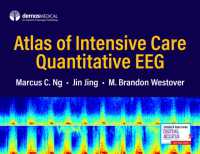- ホーム
- > 洋書
- > 英文書
- > Science / Mathematics
Full Description
This monograph attempts to provide a systematic and consistent survey of the fundamentals of the theory of free, linear, isentropic oscillations in spherically symmetric, gaseous equilibrium stars, whose structure is affected neither by axial rotation, nor by the tidal action of a companion, nor by a magnetic eld. Three parts can be distinguished. The rst part, consisting of Chaps.1-8, covers the basic concepts and equations, the distinction between spheroidal and toroidal normal modes, the solution of Poisson's differential equation for the perturbation of the gravitational potential, and Hamilton's variational principle. The second part, consisting of Chaps.9-13,is devotedto the possible existenceof waves propagating in the radial direction, the origin and classi cation of normal modes, the comple- ness of the normal modes, and the relation between the local stability with respect to convection and the global stability of a star. In the third part, Chaps.14-18 c- tain asymptoticrepresentationsof normalmodes. Chapter 19 deals with slow period changes in rapidly evolving pulsating stars.
The theory is developed within the framework of the Newtonian theory of gr- itation and the hydrodynamics of compressible uids. It is described in its present status, with inclusion of open questions. We give preference to the use of the adjective "isentropic" above that of the adjective "adiabatic", since, from a thermodynamic point of view, these stellar - cillations are described as reversible adiabatic processes and thus as processes that take place at constant entropy.
Contents
Basic Concepts.- The Equations Governing Linear Perturbations in a Quasi-Static Star.- Deviations from the Hydrostatic and Thermal Equilibrium in a Quasi-Static Star.- Eigenvalue Problem of the Linear, Isentropic Normal Modes in a Quasi-Static Star.- Spheroidal and Toroidal Normal Modes.- Determination of Spheroidal Normal Modes: Mathematical Aspects.- The Eulerian Perturbation of the Gravitational Potential.- The Variational Principle of Hamilton.- Radial Propagation of Waves.- Classification of the Spheroidal Normal Modes.- Classification of the Spheroidal Normal Modes (continued).- Completeness of the Linear, Isentropic Normal Modes.- N 2(r) Nowhere Negative as Condition for Non-Radial Modes with Real Eigenfrequencies.- Asymptotic Representation of Low-Degree, Higher-Order p-Modes.- Asymptotic Representation of Low-Degree and Intermediate-Degree p-Modes.- Asymptotic Representation of Low-Degree, Higher-Order g +-Modes in Stars Containing a Convective Core.- Asymptotic Representationof Low-Degree, Higher-Order g +-Modes in Stars Consisting of a Radiative Core and a Convective Envelope.- High-Degree, Low-Order Modes.- Period Changes in a Rapidly Evolving Pulsating Star.
-

- 電子書籍
- 西日本 「公共の宿」 改訂版 こだわり…
-

- 電子書籍
- 婚約破棄された公爵令嬢は森に引き籠りま…
-

- 電子書籍
- ティアムーン帝国物語7~断頭台から始ま…
-

- 電子書籍
- 短歌 2020年2月号 雑誌『短歌』




